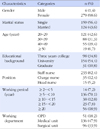Abstract
Purpose
The purpose of this research was to develop and test the validity and reliability of the Service Orientation Scale for Health Care Organization.
Methods
The Service Orientation Scale for Health Care Organization, SERV*OR, was developed through forward-backward translation methods. Internal consistency and reliability, construct and criterion validity were calculated using SPSS Statistics WIN 17.0. Survey data were collected from 283 clinical nurses in a general hospital in J province.
Results
The Service Orientation Scale for Health Care Organization showed reliable internal consistency with Cronbach's α's for the total scale ranging from .85~.91. Factor loading of the 30 items on four sub-scales ranged from .67~.83. The sub scales were named service leadership, service system, customer focus, and service control. Item convergent and discriminant validity were also established for the Service Orientation Scale for Health Care Organization. Criterion validity showed a significant correlation with customer orientation.
Figures and Tables
References
1. Lytle RS, Hom P, Mokwa M. SERV*OR: A managerial measure of organizational service-orientation. J Retail. 1998; 74(4):455–489. http://dx.doi.org/10.1016/S0022-4359(99)80104-3.
2. Čater B, Žabkar V. Antecedents and consequences of commitment in marketing research services: The client's perspective. Int Mark Manag. 2009; 38:785–797. http://dx.doi.org/10.1016/j.indmarman.2007.10.004.
3. Lytle RS. Service orientation, Market orientation, and performance an organizational culture perspective [dissertation]. Phynix: Arizona University;1994. 22–38.
4. Woo YH, Hong MY. A Study on the service orientation measurement of civil affair administration on the basis of SERV*OR Scale. Korean Public Adm Rev. 2005; 39(3):251–274.
5. Schneider B, Parkington J, Buxton VM. Employee and customer perceptions of service in banks. Adm Sci Q. 1980; 25:252–267.
6. Lytle RS, Timmerman JE. Service orientation and performance: An organizational perspective. J Serv Mark. 2006; 20(2):136–147.
7. Lee TS, Ahn SH, Kang KD. A study on the service orientation of civil service organizations: The Assessment of Psychometric Properties of SERV*OR. Daehan J Bus. 2008; 21(3):1259–1285.
8. Kim SC, Lee HS. A study of service orientation, human resource satisfaction, customer orientation effects on performance in hospital. J Korean Soc Quality Manage. 2002; 30(2):11–25.
9. Yoon JL, Jang JS. The business of medical institutions and the impact on service-oriented. Daehan J Bus. 2012; 25(2):859–878.
10. Kang DS. A study on the effects of service orientation to customer orientations, employees satisfaction and service values in Medical Service Organizations. J Bus Res. 2009; 56:247–269.
11. Seo KW. A study on the effects of service orientation to business performance in medical service organizations: Focus on the general specialty medical treatment institutions [Dissertation]. Chungju: Chungju University;2007. p. 63–78.
12. Lee HT. Effect of local medical institutions' service orientation on their employees' job satisfaction, organizational commitment and customer orientation: Focusing on the Busan area. Korean J Local Gov Stud. 2013; 17(3):383–402.
13. Kim JY, Choi KS. The causal relationship among medical service orientation, hospital image and hospital performance. Korean J Account Res. 2005; 30:281–304.
14. Han JL. Factors affecting the organizational service orientation in hospital nursing [Dissertation]. Seoul: The Catholic University of Korea;2003. 17–47.
15. Shin HK. Organizational socialization of new staff nurses and its related factors [Dissertation]. Seoul: Yonsei University;2004. 20–45.
16. Lee EO, Lim NY, Park HE, Heo IS, Kim JY, Bae JE, et al. Nursing research & statistics. Paju: Soomoonsa;2009. p. 197–270.
17. Parasuraman A, Zeithml VA, Berry LL. SERVQUAL: A mutiple item scale for measuring consumer perception of service quality. J Retail. 1988; 64:14–40.
18. Moon HJ. Influence of organizational culture, service oriented culture, and cultural strength on customer orientation of hospital employees [master's thesis]. Gimhae: Injea University;2004.
19. Ha GC. The handbook of marketing research. Paju: Idambooks;2010. p. 173–174.
20. Babbie ER. The practice of social research. 11th ed. Belmont, CA: Thomson Wadsworth;2007. p. 238–239.
21. Kang YS, Choi EH. A study on the effects of service orientation on organizational performance in the long-term care facility for the elderly. Korean J Local Gov Adm Stud. 2012; 26(3):493–516.
22. Ware JE Jr, Gandek B. Methods for testing data quality, scaling assessments and reliability: The IQOLA project approach. J Clin Epidemiol. 1998; 51:945–952.
23. Franklin C, Streeter CL, Spriner DW. Validity of the FACES IV. family assessment measure. Res Soc Work Pract. 2001; 11(5):576–596. http://dx.doi.org/10.1177/104973150101100503.
24. Zeithmal VA, Leonard LB, Parasuraman A. The behavioral consequences of service Quality. J Mark. 1996; 60:31–46. http://dx.doi.org/10.2307/1251929.
25. Dienhart JR, Gregorie MB, Downey RG, Patrick KK. Service orientation of restaurant employee. Int J Hosp Manag. 1992; 11(4):331–346. http://dx.doi.org/10.1016/0278-4319(92)90050-6.
26. Sung TJ. Modern basic statistics. 6th ed. Seoul: Hakgisa;2011. p. 117–142.




 PDF
PDF ePub
ePub Citation
Citation Print
Print







 XML Download
XML Download